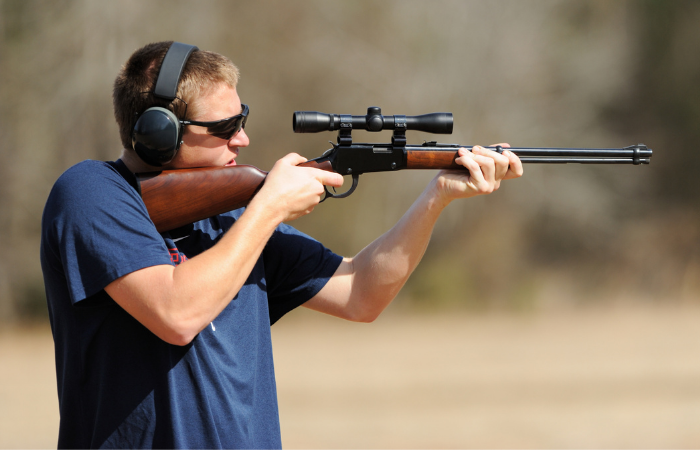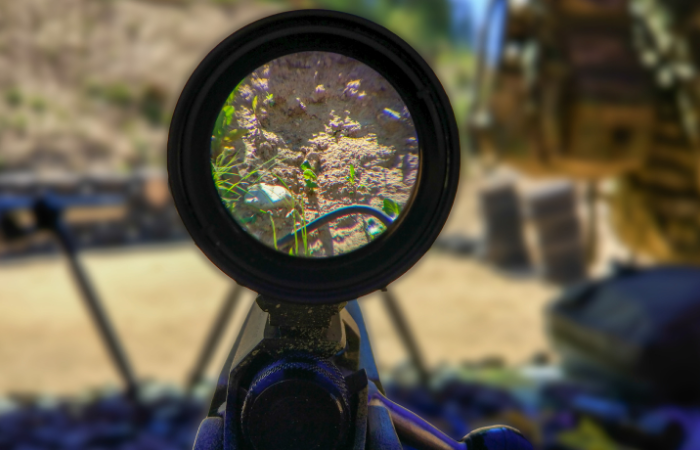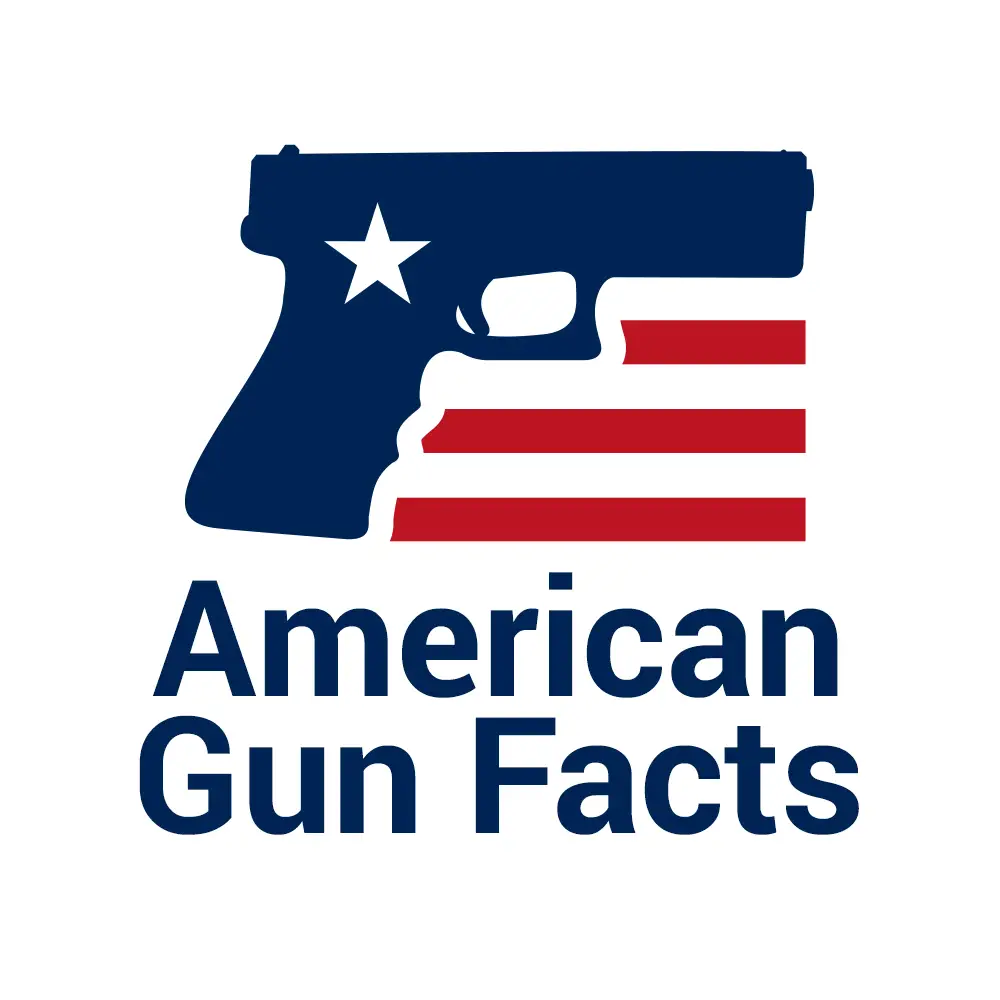A rifle scope can make it easier to hit targets that are long range. While they are simple enough to add to your gun, you can get more mileage out of them if you actually know what the numbers mean and how to adjust your aim accordingly.
The Short Answer
There are 2 sets of numbers on a scope that matter most. The first number relates to the magnification of the rifle while the second pertains to the size.
Both of them are defined by the lens’s physical curvature, thickness, and diameter size. These figures are usually accompanied by other measures such as field of vision, eye relief, elevation & windage, MOA, MRAD, tube diameter, etc
Cumulatively, these numbers can reveal what a scope has to offer the shooter.
Let’s take a detailed look at the major scope numbers, their meaning, and how they contribute to helping you land a perfect shot.
Magnification & Power (X)

The first scope numbers you need to consider relates to the scope’s magnification & power levels.
As far as a 4-12X40 scope meaning goes, it shows three things; the 4 is the minimum magnification of the scope, the 12 is its maximum, and the 40mm represents the size/diameter of the lens.
Using this scope, you can see targets at distances 4 times all the way up to 12 times beyond what your human eyesight allows.
For instance, if the set magnification is at 4X and your target is at 400 yards, the scope power will make it appear as though it’s only 100 yards away (4 times closer). The higher the magnification rating, the closer the target will seem.
Riflescopes with a fixed magnification will show a number like 6X40 where the first number shows the lens’s fixed zoom of 6 times while the second one describes the lens diameter.
Picking the Right Scope Magnification
The relationship between the image the scope provides and the target is both linear and proportional. As the magnification increases, the target will seem bigger and bigger at 2X zoom, the target will seem twice as big via the scope.
To get the best shots, you need to choose the magnification that’s just enough to help you hit the target. in other words, having too much magnification brings in certain drawbacks, such as limited FOV, complexity, distortion, etc…
On average, many shooters settle for a 10X magnification (preferably with variable levels) when trying to deal with targets up to 500 yards away.
For hunters, however, they usually prefer between 4X to 6X as most shots taken during a hunting season will mostly fall between 100 to 200 yards.
Size of the Objective lens (mm)

The last number on the sequence that comes after X relates to the size/diameter of the objective lens, which is measured in millimeters. This is the lens that closest to the target, and it’s also furthest from the rifle’s stock.
Naturally, the larger the lenses, the more light it will allow the scope to attract and makes it easier to focus. This is very useful in lowlight conditions like dusk/dawn or cloudy days as the larger lenses can still offer clearer brighter target images.
For instance, 4-12X56 will be clearer in all zoom settings, where a 4-12X32 will get darker the more it magnifies.
Most lens scope sizes range between 32mm to 44mm, though you can find models that offer from 50mm to even 80mm+ lenses. Then, there are the premium Adjustable Objective (AO) lenses, which allow you to cycle between diameters per your needs.
Picking the Right Size Scope
The diameter of the scope tube is the next big thing you wanna consider. Typically, these numbers aren’t mentioned on the scope itself, rather it will be on the box that it comes in.
The most common tube diameters are 1-inch and 30mm. The bigger the diameter of the scope tube, the more sturdy and durable it’s gonna be.
A larger tube diameter also translates to more options in terms of elevation adjustment ranges, which is crucial for long-range shooting scenarios.
This also determines which sized rings you’ll need to fix the scope of your guns. The 1-inch sized tubes are both lighter and ideal for mid-range shooting.
Eye Relief (inches)

This number represents how closer your eye will need to be to the eye piece to view the scopes full field of vision with clarity.
It’s a very important number to consider. If you operate a gun with a lot of recoils, it’s not wise to have an eye relief that requires you to hold the scope too near to your eye or shooting glasses as it increases the risk of injuries.
Typically, eye relief ranges between 3.5 inches to 6 inches. The higher this number, the more the amount of space allowed between your eye & the eyepiece without compromising your field of vision and accuracy.
Exit Pupil (mm)
Calculated in millimeters, this represents the diameter of the light that exits the eyepiece of your riflescope. The bigger the exit pupil, the brighter the image will be. Having a wide exit pupil is especially useful in low light conditions.
On average, the human eye can dilate between 5mm to 8mm depending on the amount of light currently present.
To better calculate your scopes exit pupil, divide the size of the objective lens by the scopes magnification.
For example, if your scope power is rated at 4-12X40 magnification;
- Exit pupil at the zoom of 4 = 40 / 4 = 10 mm
- Exit pupil at the zoom of 7 = 40 / 7 = 5.71 mm
As mentioned before, a human pupil can only expand up to 8 millimeters. So if you shoot mostly in bright environments, the target image will seem too exposed when working with a 40mm lens at 4X magnification, and this can affect your precision.
Field of view (FOV)

Field of view refers to the size of the area you can view through the lens. The bigger the lenses, the more FOV you can enjoy. For hunters, a larger FOV is typically better since it’s great for tracking moving targets.
Normally, a human eye’s field of vision is capped at 210 degrees horizontally. As you zoom in with a scope, your field of vision decreases as the target image fills the area.
For instance, a scope rated at 100 feet at 1000 yards means that at full magnification you can only see 100th of the usual 210 degrees.
Elevation and windage adjustments (mm)

The scope’s windage and elevation numbers determine how much you can adjust the bullets travel path up/down or left/right according to the environment when sighting in. These are measured in mm & can be adjusted via turning the scopes dials.
For example, a riflescope with a windage specification of 2.5m/100 meter means that you can adjust the reticle 1.25 mm to the right or left of the target to help adjust for wind drift & lead the bullet to the center. The same also goes for elevation, depending on the distance, you can aim the round 1 meter up or down to compensate for the “bullet arc” common to long-range shots.
Both these measurements are represented on the scope with the following terms:
- MOA (Minute of Angle) – this measures how much your bullet deviates over a given distance and is calculated in inches. For perspective 1 MOA is equal to shooting a target 200 yards away and hitting it within a 2-inch radius.
- MRAD (MilliRadian) – this determines the angle a bullet needs to travel to hit the targets with absolute precision. We can calculate the MOA for this angle measurement as roughly equal to 3.6 inches at 100 yards
Parallax
Parallax is the level of movement of the reticle in tandem with the target image.
If you move your eye slightly towards any side & the crosshairs remain steady on target, then a scope is said to be “Parallax-Free.” If, on the other hand, you shift your head while the scope stays still & the reticle moves off target, there is a Parallax error.
This is most noticeable on scopes with high-magnification ranges. Many scopes are designed to be parallax free from 15 yards to 100-150+ yards, while others offer side focus adjustments to help compensate for parallax errors at long shots.

Researched and written by the American Gun Facts team. We are a group of Americans dedicated to providing factual information on firearms and fighting back against attempts to weaken or discard the Second Amendment. We write on topics ranging from firearm statistics, news, reviews, and more! AGF has been featured in the New York Times, NBC, MSN, Time, & many other publications.

Great guide on the basic metrics for scopes, I could recommend people to this article when discussing about rifle scopes.
Outstanding!! Great information and easy to read and comprehend. Thank you so much for the time and effort to do the research necessary to put this article together for us shooters. This helped me tremendously and I can’t wait to get to the store…and then the range.
Stay safe, John C.